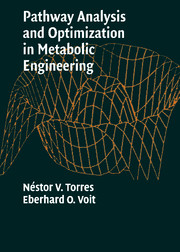Book contents
- Frontmatter
- Contents
- Preface
- 1 Target: A Useful Model
- 2 Methods of Biochemical Systems Theory
- 3 A Model of Citric Acid Production in the Mold Aspergillus niger
- 4 Optimization Methods
- 5 Optimization of Biochemical Systems
- 6 Optimization of Citric Acid Production in Aspergillus niger
- 7 Maximization of Ethanol Production in Saccharomyces cerevisiae
- 8 Conclusions
- Author Index
- Subject Index
- Plate section
Preface
Published online by Cambridge University Press: 28 July 2009
- Frontmatter
- Contents
- Preface
- 1 Target: A Useful Model
- 2 Methods of Biochemical Systems Theory
- 3 A Model of Citric Acid Production in the Mold Aspergillus niger
- 4 Optimization Methods
- 5 Optimization of Biochemical Systems
- 6 Optimization of Citric Acid Production in Aspergillus niger
- 7 Maximization of Ethanol Production in Saccharomyces cerevisiae
- 8 Conclusions
- Author Index
- Subject Index
- Plate section
Summary
If the 1990s were the decade of molecular biology, culminating in the completion of the Human Genome Project, the first decade of the twenty-first century can be envisaged as the time of applying that new knowledge to pressing problems in medicine, pharmaceutical sciences, agriculture, and, generally, the biotech industry. Advances in functional genomics and the targeted manipulation of the genetic composition of organisms, combined with unprecedented computational power and access, are in the process of forging a new subspecialty of biotechnology, called Metabolic Engineering. Metabolic engineering offers a different perspective, a fresh approach with a focus not only on the development of better tools for the biological manipulation of organisms, but also on a deeper understanding of metabolic pathways in a systemic, integrative way.
Metabolic engineering is an interdisciplinary science that has grown from numerous roots in molecular biology and biochemistry, genetics, chemical engineering, biotechnology, mathematical modeling, and systems analysis. Its targets are metabolic pathways and gene networks, often in microorganisms, and its goal is the optimization of the yield of some desired metabolite. Microorganisms are manipulated and grown at an industrial scale to produce energy (for instance, in the form of ethanol), organic solvents, gums, and pigments. The food industry relies heavily on preservatives such as citric acid, which is currently produced by microbes at a rate of several hundred thousand tons per year. The pharmaceutical industry uses microorganisms for the production of vitamins, amino acids, lipids, enzymes, and precursors for antibiotics.
Information
- Type
- Chapter
- Information
- Pathway Analysis and Optimization in Metabolic Engineering , pp. ix - xivPublisher: Cambridge University PressPrint publication year: 2002
